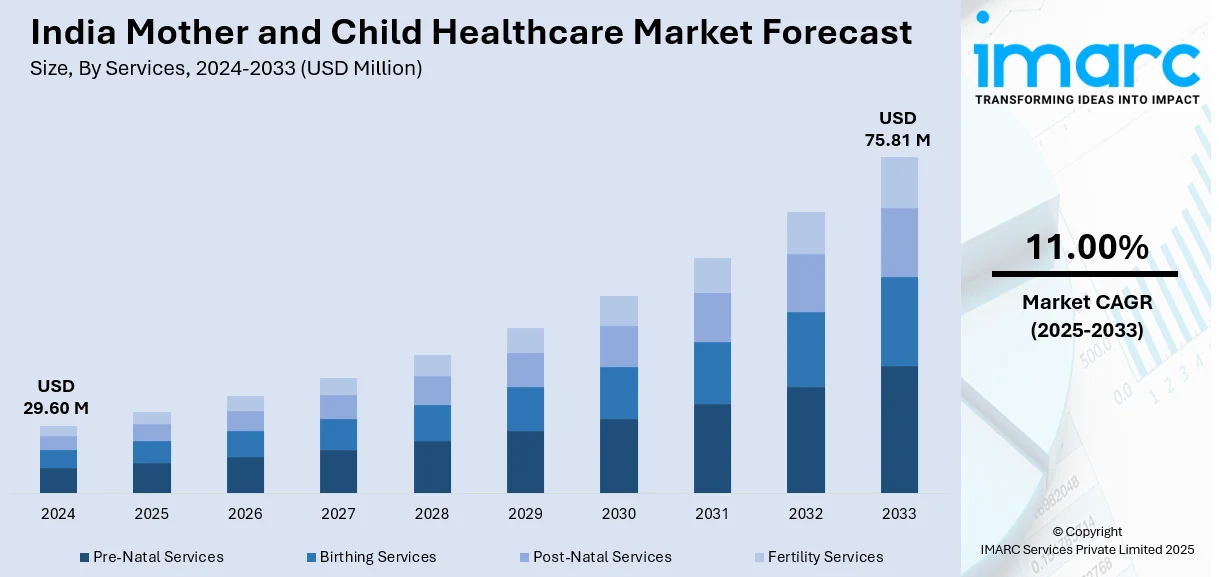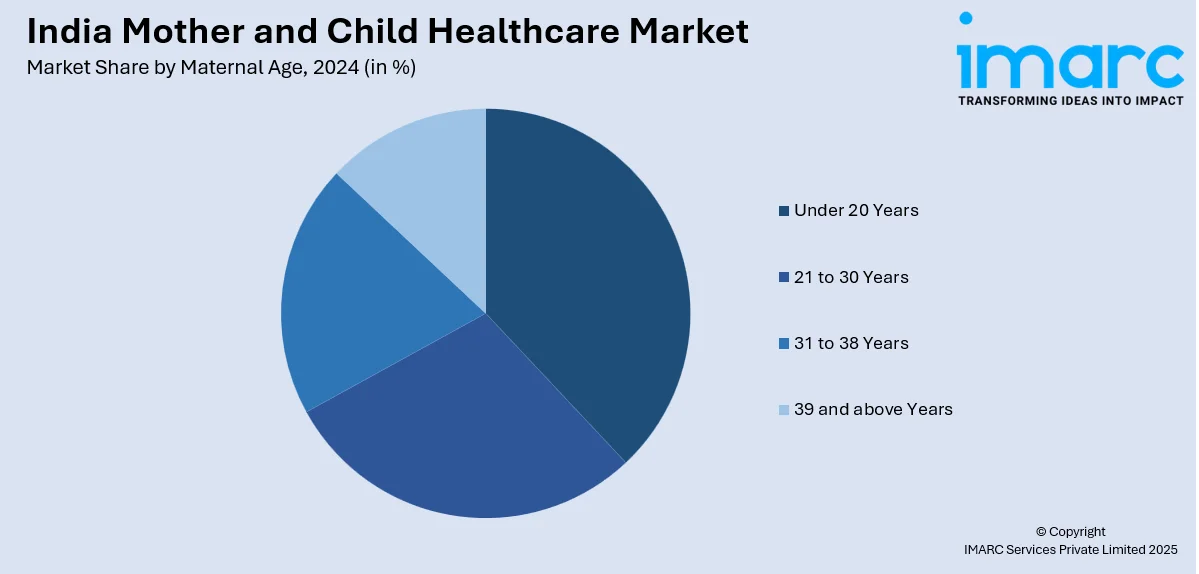
India Mother and Child Healthcare Market Size, Share, Trends and Forecast by Services, Maternal Age, Location, and Region, 2025-2033
India Mother and Child Healthcare Market Overview:
The India mother and child healthcare market size reached USD 29.60 Million in 2024. Looking forward, IMARC Group expects the market to reach USD 75.81 Million by 2033, exhibiting a growth rate (CAGR) of 11.00% during 2025-2033. The India mother and child healthcare market share is expanding, driven by the rising adoption of artificial intelligence (AI)-oriented diagnostics and predictive analytics, enabling timely interventions, along with the ongoing public-private partnerships to strengthen maternal healthcare infrastructure.
|
Report Attribute
|
Key Statistics
|
|---|---|
|
Base Year
|
2024 |
|
Forecast Years
|
2025-2033
|
|
Historical Years
|
2019-2024
|
| Market Size in 2024 | USD 29.60 Million |
| Market Forecast in 2033 | USD 75.81 Million |
| Market Growth Rate (2025-2033) | 11.00% |
India Mother and Child Healthcare Market Trends:
Advancements in technology
Advancements in technology are impelling the India mother and child healthcare market growth. Innovations in medical devices, such as fetal monitors, neonatal incubators, and portable ultrasound machines, enhance maternal and infant care, reducing complications during pregnancy and childbirth. AI-based diagnostics and predictive analytics help to detect high-risk pregnancies early, enabling timely interventions. Remote healthcare solutions bridge the gap between rural and urban areas, allowing expecting mothers to consult specialists without traveling long distances. Wearable health trackers and mobile apps allow mothers to monitor their health, track fetal growth, and receive medical advice in real time. Improved fertility treatments, advanced neonatal care units, and robotic-assisted surgeries further enhance healthcare outcomes. Besides this, companies are working to launch digital platforms to provide teleconsultations and health education. In February 2025, Babynama, India’s first digital pediatric care platform, secured USD 700K in seed funding to improve its technological framework and grow its team of pediatric experts. The capital was to be strategically deployed to expand the firm’s operations and support marketing efforts to reach a wider audience of parents in search of dependable pediatric care.

Increasing investments in healthcare initiatives
The rising investments in healthcare initiatives are offering a favorable India mother and child healthcare market outlook. In August 2024, Reckitt, the prominent consumer goods manufacturing company, broadened its ‘Self-Care for New Moms and Kids Under 5’ program to rural and indigenous areas of India. The project emphasized nutrition, sanitation, and illness prevention and aimed to enhance maternal and child health, in accordance with WHO directives. Government programs receive significant funding to refine maternal and child healthcare services, ensuring better prenatal and postnatal care. Investments in hospitals, maternity clinics, and rural healthcare centers expand access to medical facilities, especially in remote areas. Private sector participation and foreign direct investments (FDI) bring innovations in medical technologies, better-trained professionals, and modern treatment methods. Increased spending supports immunization programs, reducing infant mortality rates and preventing diseases. Research and development (R&D) efforts in maternal and neonatal health lead to improvements in fertility treatments, high-risk pregnancy management, and neonatal intensive care. As financial resources continue to flow into the sector, healthcare services have become more efficient and affordable, ensuring better health outcomes for mothers and children. Public-private partnerships also strengthen maternal healthcare infrastructure, making essential services more accessible. With the high expenditure, India moves closer to achieving better maternal and child health standards across urban and rural regions.
India Mother and Child Healthcare Market Segmentation:
IMARC Group provides an analysis of the key trends in each segment of the market, along with forecasts at the regional level for 2025-2033. Our report has categorized the market based on services, maternal age, and location.
Services Insights:
- Pre-Natal Services
- Birthing Services
- Post-Natal Services
- Fertility Services
The report has provided a detailed breakup and analysis of the market based on the services. This includes pre-natal services, birthing services, post-natal services, and fertility services.
Maternal Age Insights:

- Under 20 Years
- 21 to 30 Years
- 31 to 38 Years
- 39 and above Years
A detailed breakup and analysis of the market based on the maternal ages have also been provided in the report. This includes under 20 years, 21 to 30 years, 31 to 38 years, and 39 and above years.
Location Insights:
- Hospitals
- Nursing Homes and Clinics
- In-Home Services
- Others
The report has provided a detailed breakup and analysis of the market based on the location. This includes hospitals, nursing homes and clinics, in-home services, and others.
Regional Insights:
- North India
- South India
- East India
- West India
The report has also provided a comprehensive analysis of all the major regional markets, which include North India, South India, East India, and West India.
Competitive Landscape:
The market research report has also provided a comprehensive analysis of the competitive landscape. Competitive analysis such as market structure, key player positioning, top winning strategies, competitive dashboard, and company evaluation quadrant has been covered in the report. Also, detailed profiles of all major companies have been provided.
India Mother and Child Healthcare Market News:
- In February 2024, Rainbow Children's Hospital group, a prominent network of hospitals focused on pediatrics, gynecology, and obstetrics, released ‘Butterfly Essentials’, a dedicated store featuring a variety of items designed for catering to the specific needs of women and children. The event for the launch took place at Rainbow Children's Hospital in Banjara Hills, Hyderabad. The unique aspect of the store is its dedication to organic and natural ingredients, creating a safe and supportive atmosphere for mothers and babies.
- In May 2023, the Moms Co. India launched a new campaign, ‘For Every Mom, Through Every Change’ in India, starring brand ambassador Sonam Kapoor. It acknowledged the evolving physical requirements of mothers, honoring them as superheroes. The firm intended to provide support through toxin-free products designed specifically for mothers and infants.
India Mother and Child Healthcare Market Report Coverage:
| Report Features | Details |
|---|---|
| Base Year of the Analysis | 2024 |
| Historical Period | 2019-2024 |
| Forecast Period | 2025-2033 |
| Units | Million USD |
| Scope of the Report |
Exploration of Historical Trends and Market Outlook, Industry Catalysts and Challenges, Segment-Wise Historical and Future Market Assessment:
|
| Services Covered | Pre-Natal Services, Birthing Services, Post-Natal Services, Fertility Services |
| Maternal Ages Covered | Under 20 Years, 21 to 30 Years, 31 to 38 Years, 39 and above Years |
| Locations Covered | Hospitals, Nursing Homes and Clinics, In-Home Services, Others |
| Regions Covered | North India, South India, East India, West India |
| Customization Scope | 10% Free Customization |
| Post-Sale Analyst Support | 10-12 Weeks |
| Delivery Format | PDF and Excel through Email (We can also provide the editable version of the report in PPT/Word format on special request) |
Key Questions Answered in This Report:
- How has the India mother and child healthcare market performed so far and how will it perform in the coming years?
- What is the breakup of the India mother and child healthcare market on the basis of services?
- What is the breakup of the India mother and child healthcare market on the basis of maternal age?
- What is the breakup of the India mother and child healthcare market on the basis of location?
- What are the various stages in the value chain of the India mother and child healthcare market?
- What are the key driving factors and challenges in the India mother and child healthcare market?
- What is the structure of the India mother and child healthcare market and who are the key players?
- What is the degree of competition in the India mother and child healthcare market?
Key Benefits for Stakeholders:
- IMARC’s industry report offers a comprehensive quantitative analysis of various market segments, historical and current market trends, market forecasts, and dynamics of the India mother and child healthcare market from 2019-2033.
- The research report provides the latest information on the market drivers, challenges, and opportunities in the India mother and child healthcare market.
- Porter's five forces analysis assist stakeholders in assessing the impact of new entrants, competitive rivalry, supplier power, buyer power, and the threat of substitution. It helps stakeholders to analyze the level of competition within the India mother and child healthcare industry and its attractiveness.
- Competitive landscape allows stakeholders to understand their competitive environment and provides an insight into the current positions of key players in the market.
Need more help?
- Speak to our experienced analysts for insights on the current market scenarios.
- Include additional segments and countries to customize the report as per your requirement.
- Gain an unparalleled competitive advantage in your domain by understanding how to utilize the report and positively impacting your operations and revenue.
- For further assistance, please connect with our analysts.
 Inquire Before Buying
Inquire Before Buying
 Speak to an Analyst
Speak to an Analyst
 Request Brochure
Request Brochure
 Request Customization
Request Customization




.webp)




.webp)












